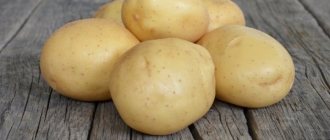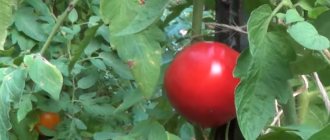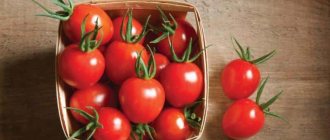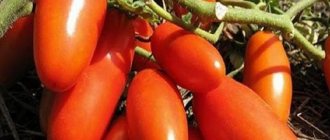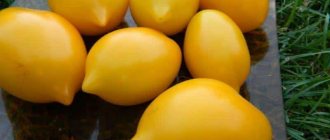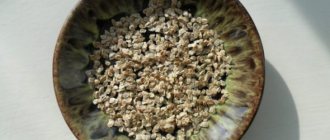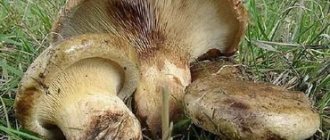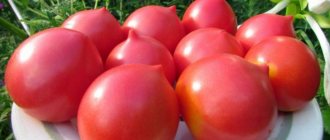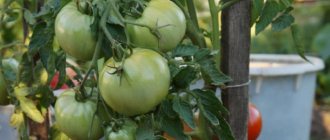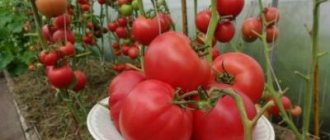The shelf life of tomatoes depends on many factors. This includes competent agricultural technology for growing plants throughout the season, and correct timely collection of fruits, and their subsequent sorting by size and degree of ripeness, and choice of location, and compliance with optimal conditions during storage (temperature, humidity, etc.).
And, of course, the initial choice of variety is very important - it’s no secret that different tomatoes differ markedly in this regard. For long-term storage, fleshy tomatoes with thick, smooth skin and medium-late and late ripening are better suited. Some of these tomatoes, if all storage conditions are met, can be kept fresh not only until the New Year, but almost all winter!
On the bushes of such tomatoes, only single fruits usually ripen (a special gene for “long ripening” is responsible for this). And before frost they are harvested unripe, green - the main part ripens during storage.
In many of these tomatoes, the “external” ripening, which many determine by the change in color to “ripe,” has nothing to do with the “internal” ripening. The seed chambers containing the contents of such tomatoes ripen much earlier than the fruit itself. Therefore, the seeds may well germinate directly in it.
The only serious disadvantage is that such tomatoes generally do not have a bright sweet taste, but rather have a rather average, “fresh” taste without an abundance of sugars and acids. However, as the proverb says, there is no friend according to taste. So, if you are interested in long-lasting tomatoes, pay attention to the following proven varieties.
Tomato New Year's
A variety of Russian selection, late ripening.
In the middle zone it is recommended for cultivation in greenhouses; in the southern regions it can be cultivated in open ground.
The plant is of medium size (above 1.5 m), indeterminate type, requires pinching and tying to a trellis. It is recommended to form this tomato into one stem.
The variety is unpretentious in cultivation, resistant to fusarium, tobacco mosaic, and cladosporiosis. Productivity – up to 3.5 kg per bush.
The fruits are flat-round in shape, medium in size (150-170 g), yellow-orange in color when fully ripe. Fruits should be collected and stored in a state of technical ripeness - green in color. The skin is smooth, dense, resistant to cracking, the flesh is pink, quite dense and juicy, crispy, of medium taste.
The fruits are well transported and have one of the longest shelf lives of similar varieties - up to March. Recommended for canning and processing.
Popular varieties of tomatoes
When independently selecting options, you should pay attention to varieties with medium-sized fruits, a small number of chambers, dense skin and pulp. Large specimens do not last long, and small ones become tasteless after ripening. Good reviews are given to varieties such as Roman Striped, Korean Long-fruited, Bella Rosa, Golden Andromeda, Pink Spam, Banana Legs, German Orange Strawberry, Pound Rosemary, Honey Drop and Kumato.
- Long Keeper. Late-ripening, determinate. The harvested crop is well stored until the beginning of January. The fruits are dense, flat-round, orange, no larger than 150 g. Cons - tomatoes rarely ripen on the bushes, pros - productivity, good taste.
- New Year. Indeterminate, mid-season variety. The harvested crop is stored for 3 to 5 months. The fruits are flat-round, dense, yellow, from 150 to 250 g. The taste is excellent and does not spoil. The only disadvantages are thermophilicity, the advantages are disease resistance and productivity.
- Giraffe. A mid-early, indeterminate, high-maintenance variety that can only be grown in a greenhouse. The fruits are round, hard, yellow, from 80 to 100 g. Pros: shelf life of more than 2 months, productivity, good taste, immunity to TMV, cladosporiosis and fusarium.
- Tsar Peter. Mid-season, determinate variety, approved for cultivation in Siberia and the Urals. The fruits are ovoid, dense, red, from 70 to 100 g. There are no disadvantages, advantages - keeping quality (up to 2.5 months), productivity, unpretentiousness, excellent taste.
- Redstone (Red stone). Mid-season, determinate, productive variety. The fruits weigh up to 150 g, are red, plum-shaped, dense, keep well until the first days of January, the taste does not deteriorate. Cons: weak immunity to viruses and fungi.
- Palmyra. Early, indeterminate. Pros: shelf life (up to 10 weeks), transportability, productivity, very good taste. Disadvantages - the variety can only be grown under cover. The fruits are flat-round, orange, up to 100 g.
- Shady lady. Early maturing, determinate hybrid. The fruits are very tasty, round, dense, red, weigh from 150 to 180 g, and are stored for a little more than 2.5 months. There are no downsides, the advantages are productivity, resistance to heat and diseases such as verticillium, fusarium, TMV, and cladosporiosis.
- Zazimok. Late, indeterminate hybrid. The fruits are round, dense, red, and last up to 2 months. Pros - productivity, excellent, rich taste, resistance to cracking, diseases and pests typical of the crop. Cons - shelf life is reduced if the summer was rainy.
- Decembrist. Mid-season, indeterminate hybrid. The fruits are round, dense, red, from 100 to 150 g. Disadvantages of the variety are the need for frequent watering, you cannot prepare seeds from the hybrid yourself, the plant is heat-loving, demanding good lighting. Pros: yield up to 17 kg/m², shelf life up to 12 weeks, excellent taste and product characteristics.
- Madame Courage. Early ripening, indeterminate hybrid. The fruits are round, from 120 to 150 g, dark pink. Productivity up to 19 kg/m². The variety has no disadvantages, but its advantages include a shelf life of up to 2 months and resistance to cladosporiosis. As it ripens, the taste improves.
Tomato Ozaltin red/yellow
The variety is high-yielding, late-ripening.
In the middle zone it is recommended for cultivation in greenhouses; in the southern regions it can be cultivated in open ground.
The plant is powerful, tall (above 1.8 m), indeterminate type, but not spreading, requires pinching and tying to a trellis. It is recommended to form this tomato into one or two stems.
The variety is unpretentious in cultivation and resistant to many diseases. Productivity – 4-5 kg per bush.
The fruits ripen in clusters, round-oval in shape, small and medium in size (60-110 g), leveled, red-orange in color when fully ripe (there is a yellow-fruited form of the variety). The skin is smooth, dense, the flesh is rich red, juicy, fleshy, with a good sweet and sour taste.
The fruits are easily transported and have a long shelf life. Recommended for fresh consumption, canning and processing.
How to collect and sort crops for storage
To maximize the shelf life of tomatoes, it is not enough to plant the right variety. It is necessary to provide the crop with competent agricultural technology and properly harvest the crop. Experienced gardeners recommend following a few tricks that will help preserve tomatoes for a long time:
- In the spring, carry out preventive treatment of seeds or seedlings to increase resistance to diseases and pests. Use Epin, Immunocytophyte or Fitosporin M as drugs.
- During the season, repeat the treatment using biological products or folk remedies. Tomatoes should be stored only if they do not contain pathogenic bacteria and microorganisms.
- The harvest for ripening should be at the stage of milky ripeness, when the fruits have already formed, but have not begun to turn brown.
- Tomatoes are cut with clean, sharp scissors or pruning shears along with the stalk to reduce the cut surface into which the pathogen can enter.
- It is best to harvest tomatoes in dry weather, until the night temperature drops below 5-8 °C. There should be no drops of rain or dew on the fruits, and they should not be heated in the sun.
Specimens damaged by diseases or pests should not be selected for storage. If necessary, they are placed separately from the others. Tomatoes collected after overnight frosts are also not suitable for long-term storage, even if they show no signs of damage.
Tomato Long Keeper
A variety of Soviet selection, high-yielding, late-ripening.
In the middle zone it is recommended for cultivation in greenhouses; in the southern regions it can be cultivated in open ground.
The plant is powerful, medium-sized (up to 1.4 m), determinate type, requires tying to a trellis, pinching is not necessary. It is recommended to form this tomato into one or two stems.
The variety is unpretentious in cultivation, resistant to fusarium, tobacco mosaic, and cladosporiosis. Productivity is about 6 kg per bush. The fruits, having reached full ripeness on the bush, may begin to crumble.
The fruits ripen in clusters, flat-round in shape, medium to large in size (150-300 g), and light pearl-orange in color when fully ripe. Fruits should be collected and stored in a state of technical ripeness - whitish-green in color. The skin is smooth, dense, the flesh is very dense, red-pink in color, good sweet taste with a slightly noticeable sourness.
The fruits are easily transported and have a very long shelf life - up to February-March. Recommended for fresh consumption, canning and processing.
Tomato Long-lasting
A variety of Russian selection, mid-late.
In the middle zone it is recommended for cultivation in greenhouses; in the southern regions it can be cultivated in open ground.
The plant is powerful, tall (above 1.5 m), semi-determinate type, requires pinching and tying to a trellis.
The variety is unpretentious in cultivation. Productivity – 4-5 kg per bush.
The fruits are flat-round, slightly ribbed, medium in size (90-150 g), and rich orange-yellow in color when fully ripe. Fruits should be collected and stored in a state of technical ripeness - green in color. The skin is smooth, dense, the pulp is very dense, orange-red in color, and has a satisfactory taste.
The fruits are easily transported and have a very long shelf life - up to February-March. Recommended for fresh consumption, canning and processing.
The best varieties and hybrids for long-term storage
Every year, breeders are paying more and more attention to breeding tomatoes that can be stored fresh for several months. The variety of varieties and hybrids with high shelf life can be divided into 3 groups, differing in the period during which the fruits remain edible:
- medium-aged tomatoes, with a shelf life of 2-3 months;
- shelf-stable varieties of tomatoes, shelf life 4-6 months;
- long-lasting tomatoes, with a shelf life of more than six months.
Tomato Snowfall F1
Hybrid of Russian selection, mid-season.
In the middle zone it is recommended for cultivation in greenhouses; in the southern regions it can be cultivated in open ground.
The plant is powerful, tall (up to 2 m), branched, indeterminate type, requires pinching and tying to a trellis. It is recommended to form this tomato into two stems.
The hybrid is unpretentious in cultivation, very cold-resistant, resistant to tobacco mosaic, and is slightly affected by anthracnose and alternaria. Characterized by an extended ripening period. Productivity – up to 4-4.5 kg per bush.
The fruits ripen in clusters, round-oval in shape, slightly ribbed towards the stalk, medium in size (100-130 g), leveled, light bright red in color when fully ripe. The skin is smooth, glossy, dense, does not crack, the flesh is aromatic, dense, red, of good taste.
The fruits are easily transported and have a long shelf life. Recommended for fresh consumption, canning and processing.
Tomato Giraffe
A variety of Russian selection, late ripening.
In the middle zone it is recommended for cultivation in greenhouses; in the southern regions it can be cultivated in open ground.
The plant is powerful, tall (above 2 m), semi-determinate type, requires pinching and tying to a trellis. It is recommended to form this tomato into one stem.
The variety is unpretentious in cultivation, resistant to brown spot, tobacco mosaic, and brown rot. Productivity – up to 3-4 kg per bush.
The fruits are round-oval, small to medium in size (60-130 g), light golden-orange in color when fully ripe. Fruits should be collected and stored in a state of technical ripeness - green in color. The skin is smooth, dense, the flesh is quite dense, with a small number of seeds, can be pink in color, and has an average taste.
The fruits are well transported and have one of the longest shelf lives of similar varieties - up to March. Recommended for canning and processing.
Rules for storing fresh crops
Harvested and sorted tomato crops with a long shelf life are provided with conditions under which ripening occurs for as long as possible. To do this, they are placed in a cool place away from apples, bananas and other fruits that emit ethylene. The presence or absence of lighting does not play a significant role. At home, you can store green tomatoes on a shelf in the refrigerator, in the cellar or in glass jars. Each option has its own subtleties.
In a refrigerator
A small number of tomatoes can be placed in the vegetable compartment of the refrigerator for ripening. It is convenient to store the harvest of cocktail varieties or cherry tomatoes. Before planting, it is advisable to wipe each tomato with a napkin and turn the cuttings up. Every day you should ventilate the shelf with tomatoes and sort out brown or reddened specimens. They release ethylene, which speeds up ripening. You can isolate the fruits from each other using individual paper packaging. Fully ripened tomatoes will retain their quality for no more than a week.
On a note! It is not recommended to store vegetables in a plastic bag. In this form, oxygen access is difficult and conditions are created for high humidity, which provokes rotting.
In the cellar or basement
The optimal solution for preserving the harvest is a cool cellar. The room temperature should be 8-15 °C. The higher it is, the sooner the tomatoes ripen. The collected tomatoes are laid out in wooden boxes in several layers (optimally 2-3). To avoid condensation accumulation, lay them out in layers of paper, newspapers or sawdust.
An important storage condition is periodic ventilation. This procedure is combined with a harvest audit. Ripe tomatoes, which begin to change color earlier than others, are transferred to a separate container. Remove specimens with signs of rotting or other damage. In a basement or cellar, the harvest can be stored for several months, depending on the variety.

